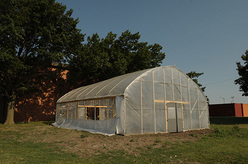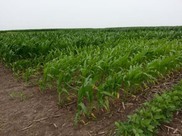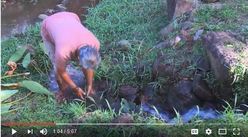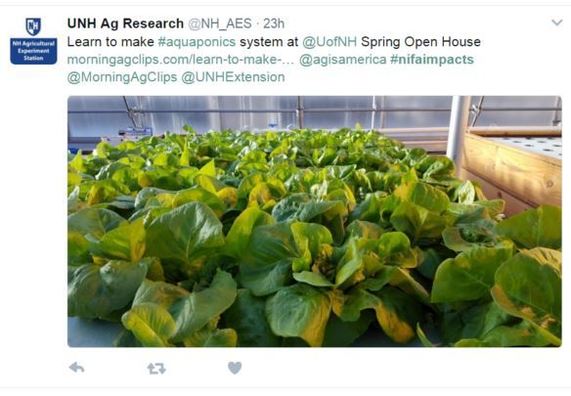|
|
|
Fresh from the Field is a weekly album showcasing transformative impacts made by grantees funded by the National Institute of Food and Agriculture.
March 16, 2017
|
|
|
The National
Institute of Food and Agriculture (NIFA) is pleased to present its 2016 Annual
Report: Today’s Science, Tomorrow’s Solutions. This year’s annual report highlights the
transformative and exciting work by NIFA-funded grantees in the areas of
research, education, and extension. Read NIFA’s 2016 annual report to learn more about how the agency’s investments are moving it closer to its vision of catalyzing transformative discoveries,
education, and engagement to address agricultural challenges.
For
the new few weeks, Fresh from the Field will feature impacts from the 2016 NIFA Annual Report available on the NIFA website.
 Rapid
safety testing for fruits and vegetables
A research
team at the Auburn University Detection and Food Safety Center
developed a new, portable, and easy-to-use screening tool to test fresh fruits
and vegetables for the presence of bacteria that cause foodborne illnesses. The
team developed biosensors that are placed directly on the fresh fruits or
vegetables. The eyelash-size biosensors are coated with antibodies and phages,
which are viruses that target specific bacteria that vibrate when placed within
an oscillating magnetic field.
Read more
about this food safety test.
|
 Low-cost
greenhouse alternative means higher profits for growers
Kansas
State University and the University of Florida are sharing an AFRI grant to learn
more about improving the freshness and shelf life of locally grown produce by
using high tunnels, an inexpensive version of a greenhouse. The researchers
discovered that, in addition to extending the growing season, crops grown in
high tunnels have a longer shelf life than crops grown in the field. A longer shelf
life makes the products more marketable and can dramatically add to the
grower’s profits. The researchers are now investigating how the light spectrum
inside a high tunnel affects the development of a plant’s natural antioxidants
with the goal of increasing its nutritional quality.
More on this story at K-State News.
|
 Flying
waterway sampling
Monitoring
and predicting water quality poses a significant challenge since sources of
fresh water and contaminants come from vast areas of land and waterways. As a
result, inconsistent, manual “grab-sampling” has been the standard for testing
water. University of Nebraska researchers are using an AFRI grant to
develop an aerial water sampling system using an unmanned aerial vehicle (UAV).
The UAV can quickly and safely deploy to hard-to-reach locations and respond to
changing scenarios. The prototype aerial water sampler has flown more than
1,000 test flights in wide-ranging sampling and sensing missions over
California, Kansas, and Nebraska, collecting samples rapidly and at low cost.
Learn more
about aerial water sampling
here.
|
 Combating
clam decline
In recent
decades, there has been a steady decline of the Manila clam on the tidal flats
of the Lummi Reservation near Bellingham, Washington. The loss of this
important food source affects the tribal food security and sovereignty
of the Lummi people. A research team from Washington’s Northwest Indian
College and Oregon State University have determined two main causes for the population decline. The decreases are caused by changes in the
clam’s food supply and a toxic sulfur compound that forms on tidal flats.
The team and Northwest Indian College students are analyzing clam feeding patterns to more effectively preserve this food supply.
Read more
about Lummi Nation tidal flats here.
|
News Coverage
 Nitrogen fertilizer provides production benefits
When
applied properly, nitrogen fertilizer can offer environmental and agricultural
production benefits, according to a recent study by agronomists from Iowa State University. The fertilizer can
lead help soil maintain carbon, which helps it retain water, which ultimately
reduces runoff and improves downstream water quality.
“Our data show that nitrogen fertilizer,
when applied at a level that maximizes crop production, is critical to maintain
soil carbon for sustainable agricultural systems,” said Michael Castellano, an
associate professor of agronomy and co-author of the study. “In fact, I’d say
it plays an essential role.” The study
was supported through NIFA’s Agriculture and Food Research Initiative (AFRI).
Read more at the Iowa State University News Service.
|
Video
 Food hubs combat food
insecurity
About 80-90 percent of food in Molokai,
Hawaii is imported, which means higher food prices for the 7,000 residents of
this island. NIFA-funded Community Food
Projects (CFPs) are creating new local food hubs to address food distribution
issues in food-insecure communities. The Molokai Food Hub (MFH) provides outreach
and education around buying, preparing, and eating more local, fresh foods –
which also increases demand for local food products.
More on the Molokai
Food Hub here.
|
Tweet of the Week
#NIFAIMPACTS
|
|
 
For more NIFA Impacts, visit nifa.usda.gov/impacts or the Land-Grant University Impacts website. Send us your NIFA-funded impacts at impactstories@nifa.usda.gov or share them with USDA_NIFA on Twitter #NIFAimpacts.
NIFA invests in and advances agricultural research, education, and extension and promotes transformative discoveries that solve societal challenges.
Fresh from the Field is a weekly compendium of news and information that may be of interest to land-grant and non-land-grant universities, NIFA stakeholders, and other subscribers.
Editor: Falita Liles; Co Editor: Carlos Harris
|
|